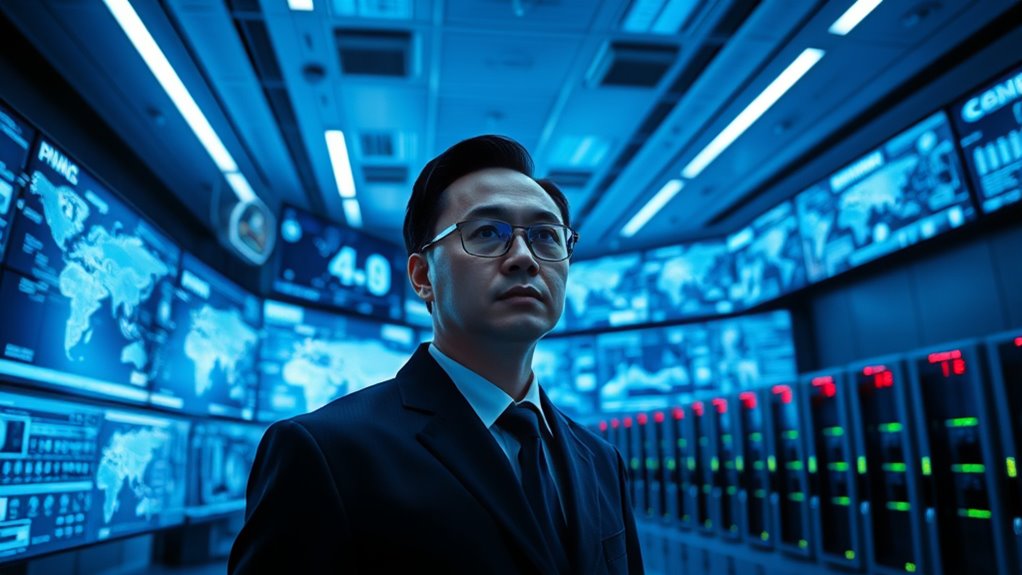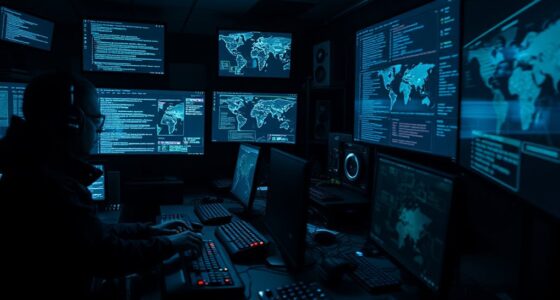China’s MSS (Guoanbu) leverages artificial intelligence to revolutionize its national security strategies. They deploy AI-driven cyber espionage tools that identify vulnerabilities and automate hacking efforts, giving them a strategic edge. Facial recognition technology tracks individuals across crowded spaces for security and control, while integrated AI systems predict threats and streamline operations. If you keep exploring, you’ll uncover how these advanced tools shape China’s evolving security landscape.
Key Takeaways
- China’s MSS integrates AI-driven facial recognition and surveillance to monitor and track individuals nationwide.
- AI algorithms enable MSS to identify vulnerabilities in foreign and domestic networks for cyber espionage.
- Machine learning enhances MSS’s ability to detect, analyze, and respond to cybersecurity threats proactively.
- AI automates intelligence collection and threat analysis, increasing MSS operational speed and accuracy.
- The MSS leverages AI to develop a sophisticated, interconnected security system for national and global security.

As China’s Ministry of State Security (MSS), or Guoanbu, increasingly integrates artificial intelligence into its operations, it’s clear that the agency is transforming how it gathers, analyzes, and acts on intelligence. You might imagine a future where traditional spying methods give way to sophisticated digital tools, and AI plays a central role in this shift. One of the key areas where AI makes a significant impact is cyber espionage. With AI-driven algorithms, the MSS can identify vulnerabilities in foreign networks more quickly and efficiently. Instead of relying solely on human hackers, they deploy machine learning systems that scan for weaknesses, analyze patterns in data breaches, and even predict future targets. This automation makes cyber espionage more precise and faster, giving China an edge in gathering sensitive information without direct physical infiltration. These AI systems continuously learn from new data, improving their ability to breach secure systems and extract intelligence covertly. As you observe this, it becomes evident that cyber espionage is no longer just about skilled hackers but also about deploying intelligent, adaptive software that operates around the clock to penetrate defenses and steal valuable intelligence. Additionally, the integration of artificial intelligence into various security domains enhances the MSS’s capacity to operate seamlessly across multiple channels and environments. Another significant AI application is facial recognition technology. You’ll notice that the MSS uses advanced facial recognition systems to monitor and track individuals across vast areas. These systems are integrated with surveillance cameras, often placed in public spaces, transportation hubs, and border crossings. By leveraging AI-powered facial recognition, the agency can identify persons of interest in real-time, even in crowded environments. This allows for rapid response to potential threats or individuals on blacklists. Furthermore, the technology isn’t static; it’s constantly refined with machine learning, which enhances accuracy over time and reduces false positives. As you walk through a monitored space, the system might be silently scanning faces, matching them against databases, and alerting authorities if a match is found. This capability extends beyond mere identification, assisting in tracking movements and gathering behavioral data. It’s a powerful tool for maintaining internal security, controlling dissent, and protecting national interests. The combination of AI-driven cyber espionage and facial recognition paints a picture of a highly sophisticated, interconnected security apparatus. It’s designed not just to react to threats but to anticipate and prevent them, leveraging the latest in AI technology to enhance China’s intelligence operations. As these tools evolve, they redefine the landscape of state security, making it more proactive, pervasive, and efficient. For instance, the deployment of cybersecurity vulnerabilities detection tools enables the MSS to stay ahead of potential cyber threats and exploit weaknesses in foreign defenses more effectively. Advances in machine learning further allow these systems to adapt to new threats without constant human intervention. Moreover, the use of data analysis techniques allows for comprehensive monitoring of vast amounts of information, improving decision-making processes. Recognizing the importance of AI-driven automation, the MSS can streamline its operations and respond more swiftly to emerging threats.
Frequently Asked Questions
How Does MSS Use AI for Domestic Surveillance?
You might wonder how AI is used for domestic surveillance. The MSS employs facial recognition to identify individuals quickly in public spaces, while data mining helps analyze vast amounts of information to detect threats or dissent. These tools allow you to be monitored more efficiently, enabling authorities to track activities and gather intelligence in real-time. AI enhances surveillance capabilities, making it harder for you to avoid detection or privacy.
What Are the Legal Boundaries of MSS AI Operations?
Imagine you’re overseeing AI-driven surveillance, like tracking online activity to prevent unrest. The legal boundaries of such MSS AI operations are complex, with limited legal oversight and ongoing ethical concerns. You must balance national security with privacy rights, ensuring compliance with laws—but these regulations are often vague or untested. This ambiguity raises questions about accountability, making it essential to establish clear guidelines to prevent misuse and protect individual freedoms.
How Does AI Enhance MSS Intelligence Gathering Capabilities?
You see AI substantially boost MSS intelligence gathering by enabling advanced cyber espionage and data analytics. It helps you quickly sift through vast amounts of digital information, identify patterns, and uncover hidden threats or targets. AI’s automation allows you to conduct operations more efficiently, making real-time decisions and staying ahead of adversaries. This technology transforms traditional intelligence methods into faster, more accurate processes, giving you an essential edge in national security efforts.
Are There International Collaborations Involving MSS and AI Tech Firms?
You might wonder if the MSS collaborates internationally with AI tech firms. While specific details are often classified, there are indications of international partnerships aimed at advancing AI capabilities. However, these collaborations are likely affected by AI export regulations, which restrict the transfer of sensitive technology. Such regulations shape how the MSS and foreign companies work together, balancing innovation with security concerns in global AI development.
What Privacy Protections Are in Place for Citizens Regarding MSS AI Tools?
You should be aware that privacy concerns arise with MSS AI tools, as they can monitor and analyze data extensively. While some regulations claim to protect citizen rights, enforcement may vary, and oversight isn’t always transparent. It’s important to stay informed about policies that aim to safeguard your privacy, but remain cautious, as these tools could still pose risks to your personal information and rights without clear, consistent protections in place.
Conclusion
As you consider China’s integration of AI into its MSS, remember that over 50,000 surveillance cameras now monitor public spaces daily. This staggering number highlights how state security is evolving with technology, shaping a world where privacy diminishes and control intensifies. It’s a powerful reminder that as AI advances, so does the reach of surveillance—prompting you to think about the balance between security and personal freedom in the digital age.









